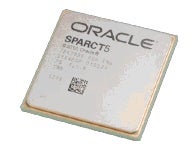Oracle is refreshing its SPARC server lineup with new T5 and M5 systems that redefine the top-end for server performance.
The new T5 SPARC processor is a step up from the T4 that Oracle announced in September of 2011.
Marshall Choy, Oracle’s director of systems solutions and business planning, explained to ServerWatch that Oracle is now positioning the T4 as the entry level for SPARC systems. The T5, which will be available in a single-socket blade as well as two-, four- and eight-socket rack server configurations, is set to be the mid-range of Oracle’s server portfolio.
The M5 will represent the high-end SPARC system with a 32-socket server system. Both the T5 and the M4 are derived from the same S3 core SPARC architecture.  The T5 has 16 cores per processor, while the M5 has a six-core architecture and a larger memory cache.
The T5 has 16 cores per processor, while the M5 has a six-core architecture and a larger memory cache.
T5
The T5 processor includes 16 SPARC v9 cores, with 8MB of shared Level 3 cache and 128K of Level 2 cache per core. Oracle is clocking the T5 with a 3.6 GHz frequency to start.
Security is baked into the T5 with Crypto Instruction Accelerators integrated into the cores for high-speed SSL, AES, 3DES and RSA encryption and decryption.
In terms of servers, the top-end offering of the T5 portfolio is the new SPARC T5-8 server, which is an 8-socket system. In total, an 8U SPARC T5-8 server can scale up to 128 processor cores and with up to 4TB of memory, and as many as 16 PCIe 3.0 cards can be plugged into the server, providing additional I/O options.
In terms of external connectivity, the SPARC T5-8 has 4x 10GbE and 4x USB 3.0 ports.
M5
At the top end of the new M5 server portfolio is the M5-32 server. 32 M5 processors fit into the server, each with a six-core, 3.6 GHz SPARC processor. The M5 has a 48 MB Level 3 cache on each chip, and in total the M5-32 server system can provide 32 TB of memory and deliver 1,536 processor threads of throughput.
There is space inside the M5-32 chassis for 32 internal storage drives and 64 PCIe 3.0 cards.
M5 vs T5
The big difference between the T5 and the M5 is the cache size and the core count. Choy explained that the difference in cache is all about scalability for different types of workloads. He noted that the M5-32 is well suited for vertically-scaling applications that benefit from a large contiguous memory footprint.
Both the M5 and T5 servers run Oracle’s Solaris Unix 11.1, which is already optimized for new SPARC processors. Solaris 11.1 was released in October of 2012.
Sean Michael Kerner is a senior editor at InternetNews.com, the news service of the IT Business Edge Network, the network for technology professionals Follow him on Twitter @TechJournalist.

